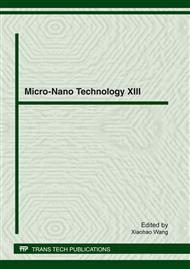p.71
p.75
p.81
p.87
p.91
p.97
p.103
p.108
p.114
Simulation of Characteristic of a Thermoelectric Power Sensor Based on MEMS Technology
Abstract:
A thermal equivalent model based on Fourier equation is introduced to optimize a thermoelectric microwave power sensor in this paper. The different distance between the load resistor and thermopile is considered carefully to obtain good matching characteristic and high sensitivity characteristic. The sensitivity of the thermoelectric power sensor has been chosen as a goal function with the distance, the length of thermopile and the number of thermopiles as independent variables. The simulation results show that the sensitivity of the power sensor decreases with the distance, but increases with the length and the number of thermopiles. Then the input matching characteristic of this thermoelectric power sensor with different distance are simulated with HFSS. The power sensor has a good performance on sensitivity characteristic and input match characteristic with an optimization distance is about 10μm.
Info:
Periodical:
Pages:
91-96
Citation:
Online since:
February 2012
Authors:
Keywords:
Price:
Сopyright:
© 2012 Trans Tech Publications Ltd. All Rights Reserved
Share:
Citation:


